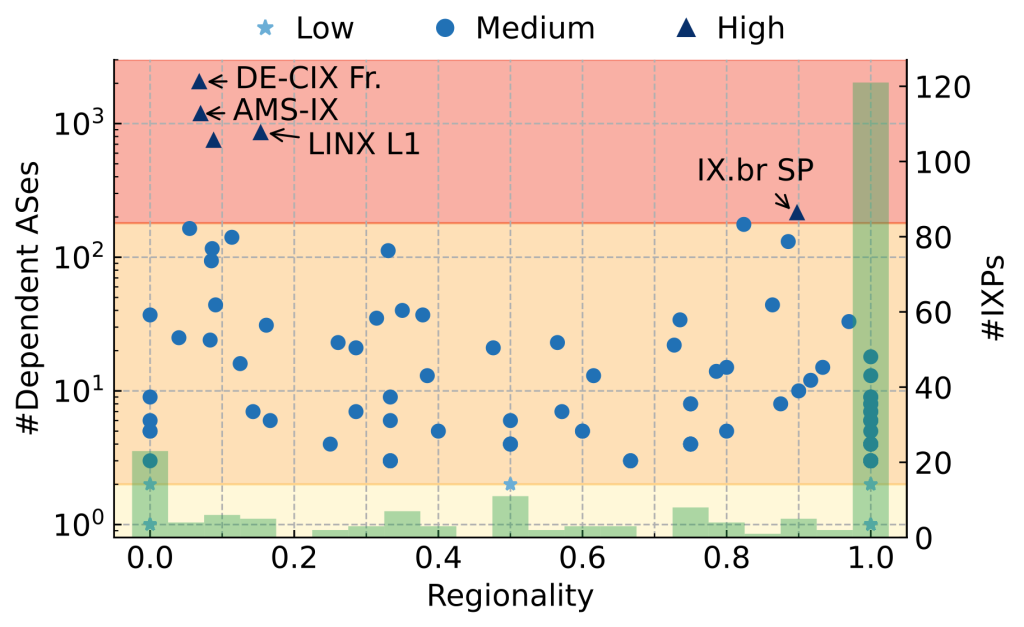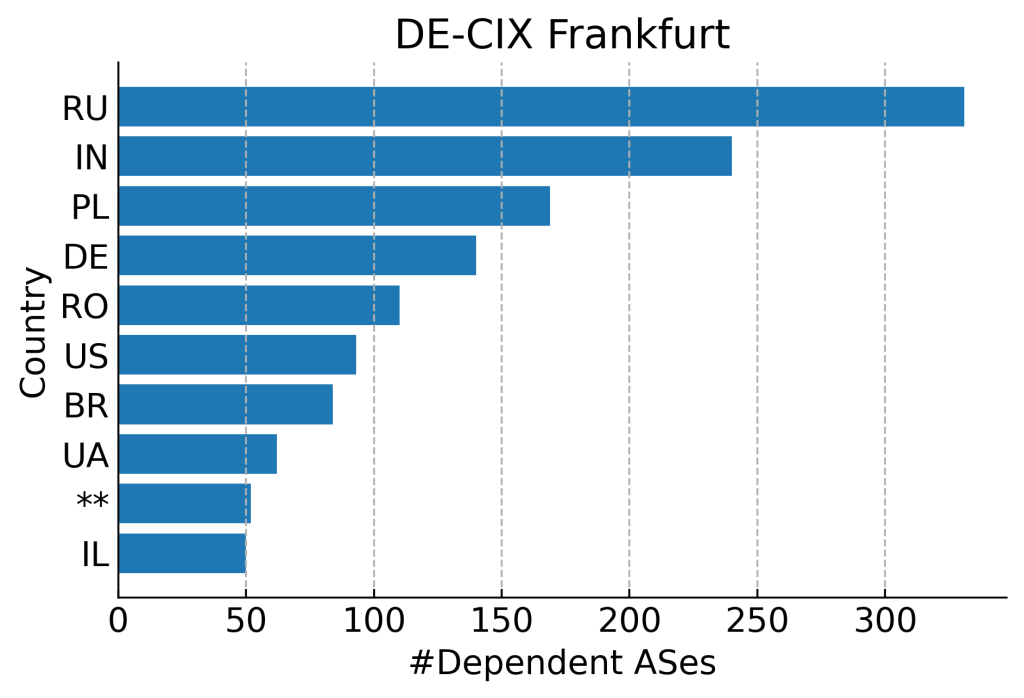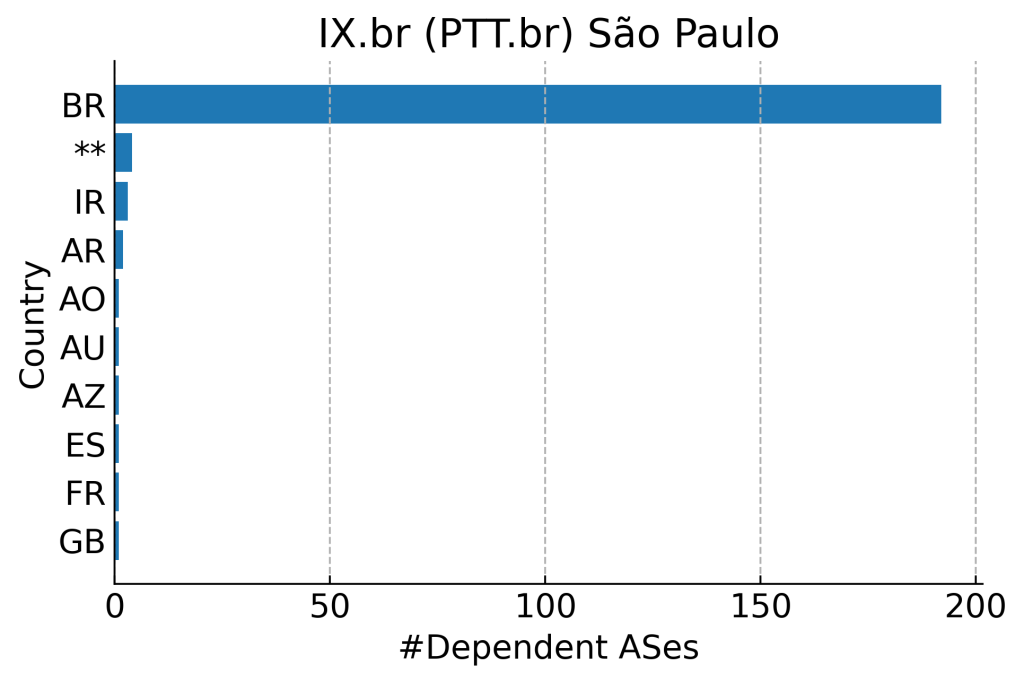Internet exchange points (IXPs) have become essential to the Internet topology. They foster direct connections between domestic networks, minimize latency, and potentially reduce costs.
While the original idea of IXPs was to promote connectivity between physically close networks and “keep local traffic local,” some of them have outgrown this role and developed into international transit hubs. This evolution inspired my colleagues and me at IIJ Research Laboratory and the National Institute of Informatics, Japan, to study the footprint of IXPs in the Internet topology. We aim to quantify the importance of IXPs beyond their members: Are other networks deeper in the topology inadvertently depending on them?
To achieve this goal, we modeled the Internet topology (see Figure 1) as a graph of nodes representing autonomous systems (ASes or networks) and IXPs. Links between these nodes indicate interconnection between networks, directly or via an IXP. We built this graph using large-scale traceroute measurements from RIPE Atlas and CAIDA Ark.

We then analyzed the paths available to reach a target network from all other networks in the graph. The importance of a node is proportional to the number of paths that traverse it. If a significant number of paths traverses a node to reach the target network, the network has a dependency on the node, which can either be another network or an IXP. We can infer the dependency relationships in the Internet topology by targeting all networks in our graph.
Charting 213 IXPs
We characterized IXPs by the number of networks (ASes) that depend on them and the geographical location of these networks.
Figure 2 shows data for 213 IXPs with dependent networks. At the top left are IXPs with around 1000 networks depending on them (Annotated: DE-CIX Frankfurt, AMS-IX, LINX LON1, and IX.br São Paulo). These are orders of magnitude more than most other IXPs in our dataset, indicating their importance for other networks.

However, we also see the Regionality of the dependent networks. The Regionality score of an IXP reflects the share of dependent networks in the same country as the IXP. For the IXPs with many dependents, we see a regionality of less than 0.2, indicating that less than 20% of their dependents are in the same country. This shows they have an international reach, even impacting networks in other countries.
In contrast, most IXPs have a Regionality of 1 (120 as shown by the green bars), indicating that all their dependents are in the same country and thus can be seen as a regional hub. This implies that IXPs acting as large international transit hubs are the exception rather than the norm.
Number of Members Alone is Not a Reliable Indicator of how IXPs Are Used
Finally, we compared two of the largest IXPs — DE-CIX Frankfurt (1,050 members) and IX.br São Paulo (2,246 members) — to highlight their different business models. As shown in Figure 1, the two have very distinct characteristics regarding the number and location of dependents.
We can drill down at the location of the dependent networks in Figure 2 and see a clear distinction between our two candidates: DE-CIX Frankfurt is extremely international; the countries with the most dependent networks are Russia, India, and Poland. Germany, the country of origin of DE-CIX, is ranked fourth. This is in stark contrast to IX.br São Paulo, which not only has a lot fewer dependents, but almost all of them are located in the same country as the IXP, Brazil. This figure shows only the top 10 countries; the list grows to 95 countries for DE-CIX.
Figure 3 — The top 10 countries with the most dependent networks for DE-CIX Frankfurt and IX.br São Paulo. Seven hundred twenty-three dependent networks from 85 countries for DE-CIX and seven dependents from 7 countries for IX.br are not shown.
This comparison shows that the size of an IXP in terms of members alone is not a reliable indicator of how it is used: DE-CIX Frankfurt is a large international transit hub, while IX.br São Paulo seems to keep local traffic local.
We have only begun the study of IXP dependencies, but it will be a valuable addition to the plethora of tools available to analyze the resilience of the Internet. See the accompanying website of our PAM 2024 paper to learn more about our study’s methodology, results, and limitations.
Malte Tashiro is a researcher at IIJ Research Laboratory. His research focus is on Internet topology analysis and Internet measurements.
Photo adapted from original by Matthew Paul Argall on Flickr
The views expressed by the authors of this blog are their own and do not necessarily reflect the views of the Internet Society.




